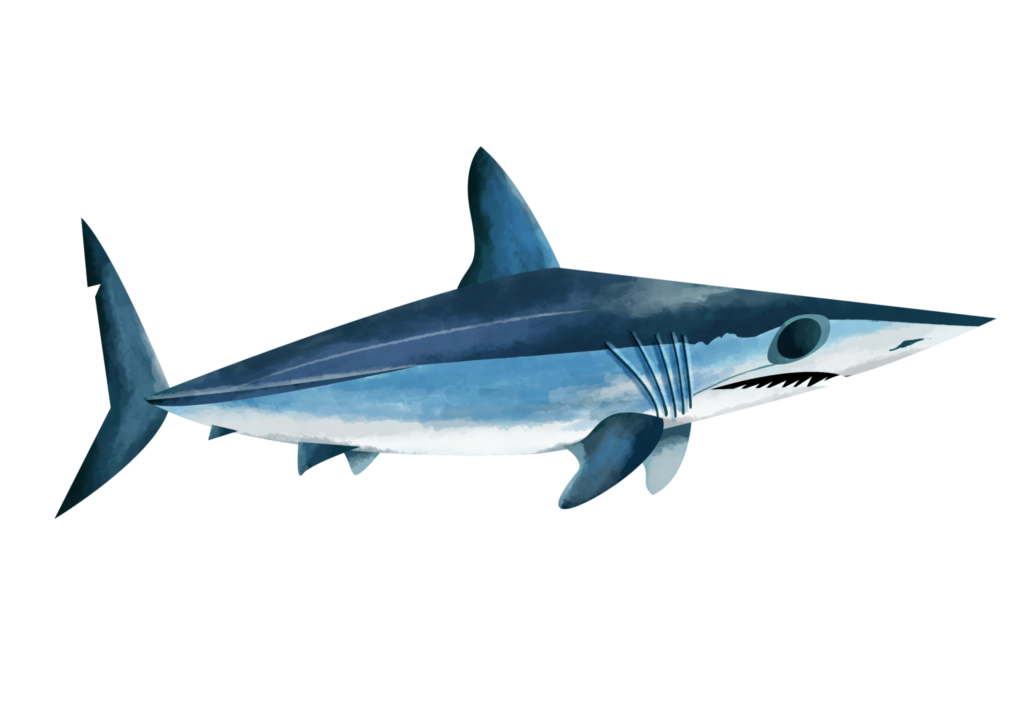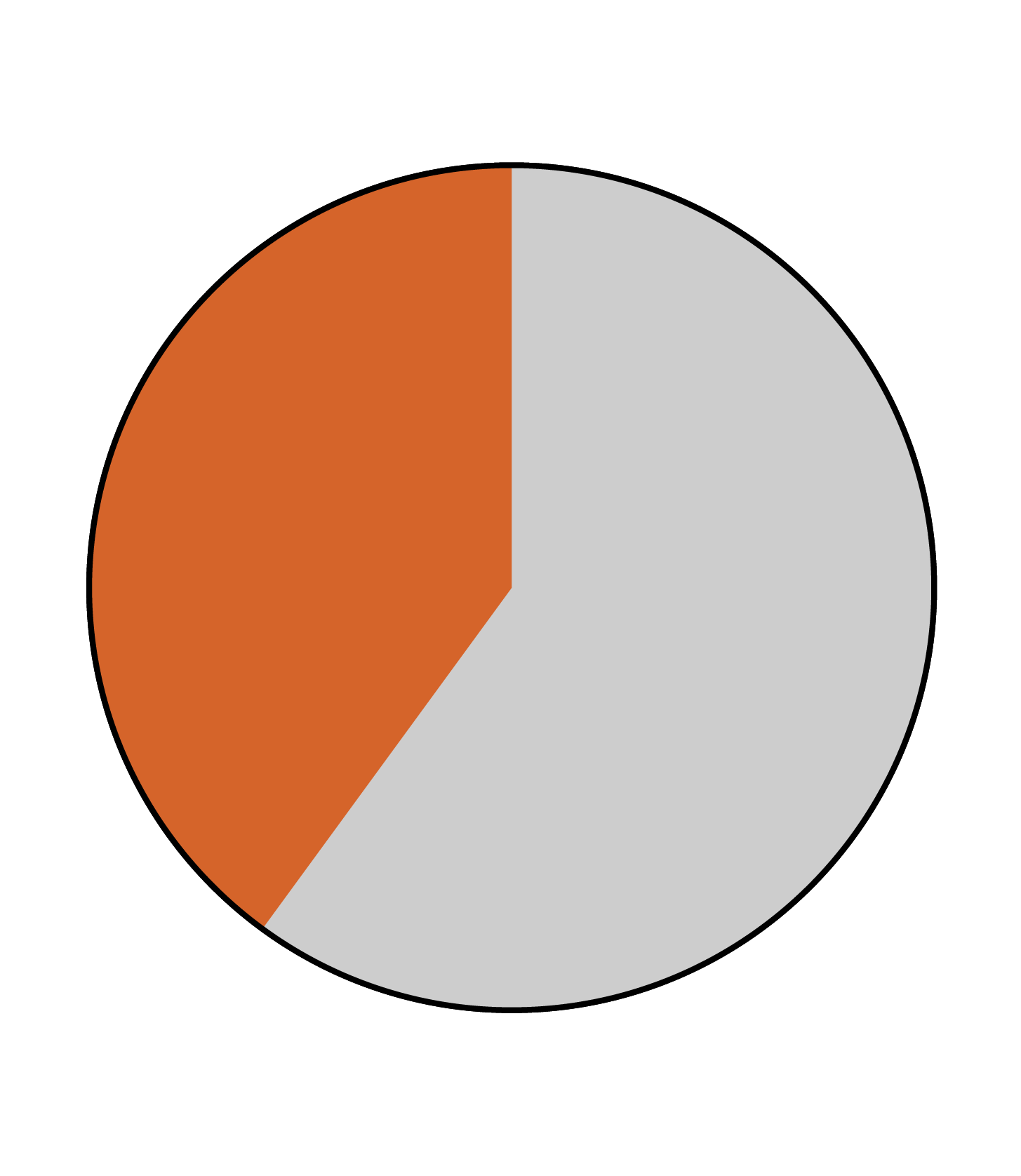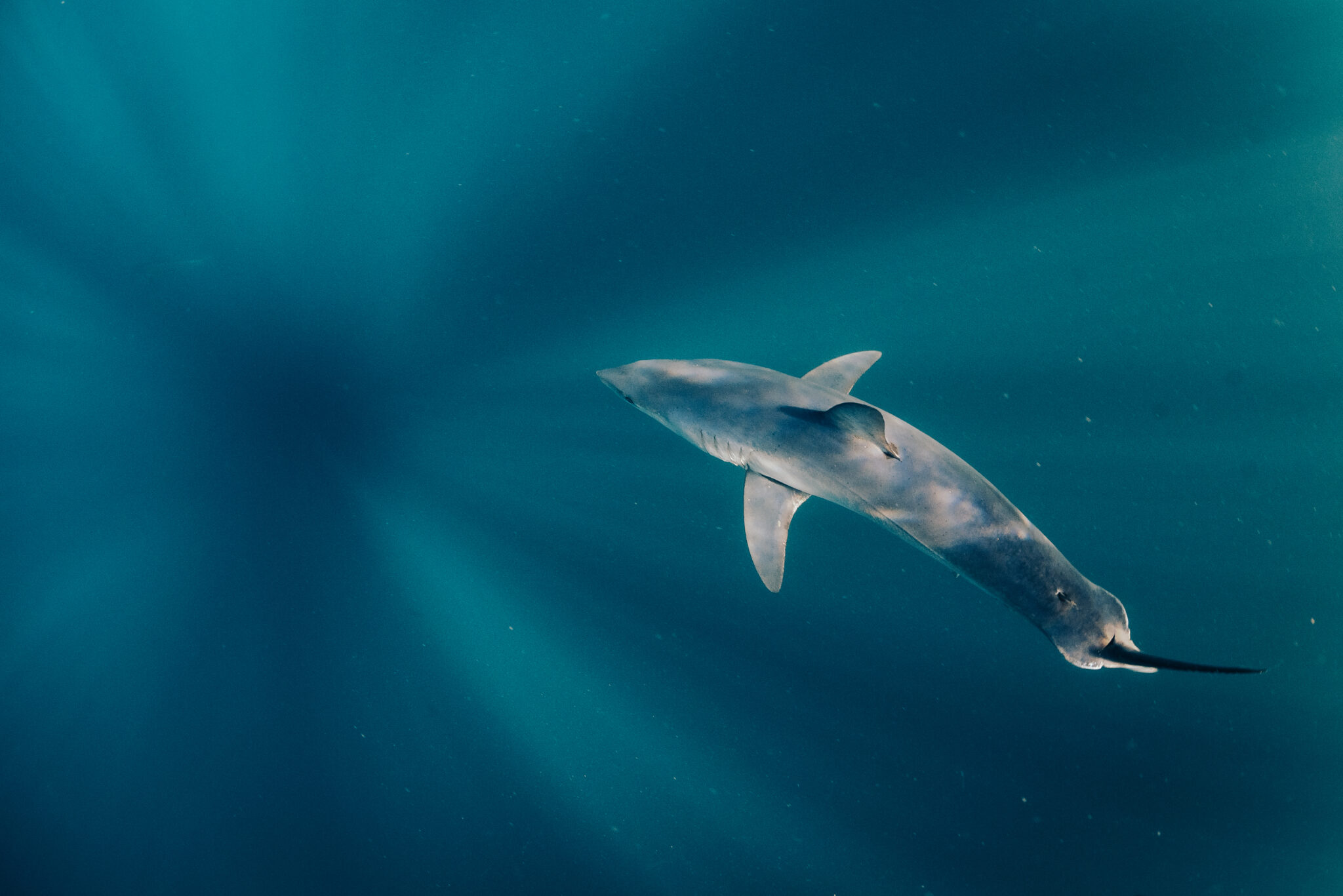Shortfin mako shark
Isurus oxyrinchus



Considered the fastest species of shark in the world, shortfin mako sharks are built for speed. Their streamlined, torpedo-shaped body, powerful muscular tail and specially adapted skin allows them to reach speeds of up to 70km/hr. This enables shortfins to hunt a range of equally speedy prey, such as tuna. They are a highly valuable shark on the international market, and have declined rapidly due to overfishing

Identification
Shortfin makos have a hydrodynamic, torpedo-shaped body with a pointed snout and large, black eyes. They have a u-shaped mouth with long teeth that often protrude from the mouth in larger individuals. The pectoral fins are relatively short in relation to their body size. Shortfins also have distinctive colouration, ranging from purple to bright, metallic blue on the dorsal side with a white underside.
Special behaviour
The fastest and most active shark in the world, shortfin makos are known for their powerful bursts of speed and can chase down fast-moving prey, like tuna, mackerel and swordfish. This athleticism continues out of the water; shortfin makos frequently leap out of the water while hunting, sometimes reaching heights of 20 feet. This behaviour is known as breaching. They have been observed ‘lunging’ at prey from below, tearing off fins and tails first to prevent prey from escaping. Shortfin makos are also highly migratory, travelling vast distances across the oceans.
Reproduction
Shortfin makos are viviparous, meaning that the young are nourished via the placenta and born live. They are very slow to reproduce. Females only reach sexual maturity at 18 to 21 years and have a gestation period of 15 to 18 months, with a three-year reproductive cycle. This means they will only produce 3 to 4 litters in their lifetime. Litter size varies from 4 to 25 pups, but an average litter will have 10 to 18 pups.
Habitat and geographical range
Shortfin makos have a global distribution at tropical and temperate latitudes. They are typically found in water warmer than 16°C, but have been known to dive to deep water colder than 10°C. Shortfins are a pelagic shark, primarily found in oceanic waters but have also been found in coastal habitats where the continental shelf is short. Critical habitats, like pupping grounds, are still relatively unknown.

Diet description
Shortfin makos feed on other fast-moving pelagic bony fishes, including swordfish, tuna and other shark species. They also predate on cephalopods, namely squid, sea turtles and marine mammals, including dolphins.
Threats
Shortfin makos are highly sought after for their fins and meat, making them a target for fisheries in the high seas. They are the second-most common shark caught by longline and net fisheries, and in 2017 the International Commission for the Conservation of Atlantic Tunas (ICCAT) declared the north Atlantic population as ‘overfished’. They are also caught accidentally as by-catch by fisheries targeting their preferred prey species, tuna and swordfish. Shortfin makos are in decline worldwide due to this combination of target and non-target fishing practices.
Relationships with humans
Due to their speed, power and size, shortfin makos are often considered a danger to humans. However, there are few accounts of unprovoked attacks on humans. The majority of injuries caused by shortfin makos have occurred when the shark is caught on fishing line.
Shortfin makos are considered one of the great gamefishes of the world and are a popular attraction for sport anglers. They are also an exceptionally valuable species in the international trade of shark meat and fins, driving commercial fisheries to target shortfin makos in the high seas. Overfishing has resulted in severe population decline, leading scientists to call for stricter fisheries regulations. In November 2021, after years of campaigning, ICAAT members agreed to a retention ban on shortfin makos in the North Atlantic for the years 2022 to 2023 to allow for population recovery.
Fun facts
The key to the shortfin’s athleticism is its specially adapted skin. All shark skin is made up of teeth-like scales, called dermal denticles, that reduce drag. But on a shortfin mako they vary in size and shape, and the denticles are flexible on certain parts of the body that experience the most water flow. This allows them to bend at an angle of 40 degrees – an action known as ‘bristling’ – which helps to push water over the body more efficiently.
Their hydrodynamic skin has been used as inspiration for swimwear, which was banned from some international competitions because of its potential hydrodynamic advantage (although some scientists have now disputed this).
Recent studies have found genes in the liver of shortfin makos that play a crucial role in tumour suppression, and have added to the growing body of evidence relating to cancer resistance in sharks. These could be used to improve cancer treatments in humans.
They have the ability to maintain their body temperature several degrees above that of the surrounding water, which gives them heightened sensory capabilities and allows for those super-fast bursts of speed.
References
David A. Ebert et al. 2021. Sharks of the World: A Complete Guide.
IUCN Red List of Threatened Species, Shortfin mako shark Isurus oxyrinchus Sims et al. 2018. Shortfin mako sharks are threatened by inaction. Science, 359, pp. 1342
Campana et al. 2016. Discards, hooking, and post-release mortality of porbeagle (Lamna nasus), shortfin mako (Isurus oxyrinchus), and blue shark (Prionace glauca) in the Canadian pelagic longline fishery. ICES Journal of Marine Science, 73(2), pp.520-528.
Patricia et al. 2019. Morphological characterization and hydrodynamic behavior of shortfin mako shark (Isurus oxyrinchus) dorsal fin denticles. Journal of Bionic Engineering, 16(4), pp.730-741.
Lang et al. 2014. Movable shark scales act as a passive dynamic micro-roughness to control flow separation. Bioinspiration and Biominimetics, 9(3), pp. 036017.
Domingues et al. 2020. Comparative eye and liver differentially expressed genes reveal monochromatic vision and cancer resistance in the shortfin mako shark (Isurus oxyrinchus). Genomics, 112(6), pp. 4817-4826
Florida Museum, Discover Fishes: Isurus oxyrinchus.





